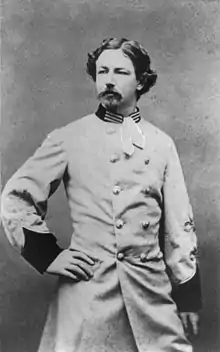William McNeill Whistler
Dr. William McNeill Whistler (July 22, 1836 – February 27, 1900) was an American Confederate soldier and surgeon. He was the younger brother of artist James McNeill Whistler, who painted Whistler's Mother.
William McNeill Whistler | |
|---|---|
 Dr. William McNeill Whistler, C.S.A. | |
| Personal details | |
| Born | July 22, 1836 Lowell, Massachusetts |
| Died | February 27, 1900 (aged 63) England |
| Resting place | Hastings, East Sussex, England |
| Spouse(s) | Ida Bayard King Whistler, Helen Euphrosyne Ionides Whistler |
| Relations | James McNeill Whistler (brother) |
| Mother | Anna McNeill Whistler |
| Father | George Washington Whistler |
| Education | Columbia College Trinity College University of Pennsylvania School of Medicine (MD) |
| Military service | |
| Allegiance | |
| Branch/service | |
Life
Whistler was born in Lowell, Massachusetts, the second son of George Washington Whistler and Anna McNeill Whistler. His father was a former soldier who abandoned a military career to become a civil engineer specialising in railroad construction. In 1842 Czar Nicholas I hired him to build the Saint Petersburg–Moscow Railway, and he brought his family out to Saint Petersburg the following year. The Whistlers would spend the next five years in Russia, leaving in 1848 to escape a Cholera epidemic that would claim the life of George Whistler the following year.
Anna Whistler returned to the United States with her two sons, settling in Pomfret, Connecticut. William attended Christ Church School in Pomfret, and St James College in Williamsport, Maryland. In 1853, he entered Columbia College with the class of 1857 but never graduated.[1] He resumed his studies in March 1855, enrolling as a pre-medical student at Trinity College, Hartford, CT. In 1857 he was apprenticed to Dr James Darrach of Philadelphia, beginning his studies at the Pennsylvania Medical School the following year.[2] He graduated with an MD from the University of Pennsylvania in 1860.[3] While in college he was a member of the Delta Psi fraternity ( AKA St. Anthony Hall ). There were chapters at each of the three colleges he attended. Later in 1860 he married his cousin,[4] Florida "Ida" Bayard King from Georgia. His southern wife, and his North Carolina-born mother, encouraged him to support the Confederacy in the upcoming Civil War.[5]
The couple settled in Richmond, Virginia, where Whistler was initially unsuccessful in his attempt to enlist as a medical officer in the Confederate States Army. It was not until the fall of 1862 that he was appointed as an assistant surgeon operating in the Richmond area.[5] This work included service in various Richmond locations including Libby Prison, and Drewry's Bluff.[2] During this period, Ida fell ill, and she died in March 1863 whilst nursed by her mother in law.[5]
In April 1864 Dr Whistler was given a field assignment, becoming assistant surgeon in the 1st South Carolina Rifle Regiment or "Orr's Rifles".[5] Arriving at his post in time for the battle of Spotsylvania Court House he made a favourable impression on his new comrades "[ordering] his servant to take his horse to the rear and out of danger, while he remained with the line of battle until it entered the Bloody Angle, and he was detained to look after such as had fallen in the charge."[6] He took part in the battles of Jericho Ford, Riddle's Shop, Petersburg, Deep Bottom, Fussell's Mill, Ream's Station and Jones's Farm.[6]
In February 1865, Whistler was granted a four month furlough to visit his mother, who was now living in London. Reporting at Richmond he was also given government dispatches to deliver to Britain. Attempts to reach Charleston, South Carolina and Wilmington, North Carolina to sail on a blockade runner were frustrated by Union troop movements. Ultimately he teamed up with another Confederate officer and slipped across the Chesapeake and through the Union lines to Philadelphia. He made his way to New York and sailed for London aboard the SS City of Manchester. A week after his arrival in Britain he learned of Robert E. Lee's surrender at Appomattox Court House.[6]
Whistler never returned to America. He spent a year travelling in Europe before continuing his medical career, first in Paris, then at St George's Hospital in London.[5] He became an MRCS in 1871 and an MRCP in 1876.[3] He was a founder and senior physician at the London Throat Hospital, was president of the British Laryngological, Rhinological and Otological Association, and published two papers on the subject of Syphilis of the Larynx.[7][8]
In April 1877, William married for a second time. His bride, Helen Euphrosyne Ionides (1849-1917) came from a wealthy Greek merchant family from Tulse Hill and was an occasional model for James Whistler.[9] Whistler did not have any children. He died on February 27, 1900, and is buried at Hastings Cemetery and Crematorium, Hastings, East Sussex, England.[3]
References
- Catalogue of Matriculants who Have Not Graduated, 1758-1897. New York: Columbia University. 1897. p. 21.
- "William McNeill Whistler, 1836-1900". The Correspondence of James McNeill Whistler. University of Glasgow.
- "Obituary". The Lancet. 155 (3993): 737–738. March 1900. doi:10.1016/S0140-6736(01)95476-5.
- Sutherland, Daniel E (July 3, 2015). "The Extraordinary Life of Whistler's Mother". The Conversation.
- Coddington, Ronald S. (November 15, 2011). "Whistler's Brother". Opinionator. New York Times.
- Hemphill, Robert R. (June 1900). "William McNeill Whistler, M.D." Confederate Veteran. 8 (6): 282–283.
- Whistler, William McNeill (1879). Lectures on Syphilis of the Larynx. London: J & A Churchill.
- Whistler, William McNeill (1881). Notes on Operations in Syphilitic Strictures of the Larynx. London: Pardon & Sons.
- "Whistler Family". Friends of Hastings Cemetery.
